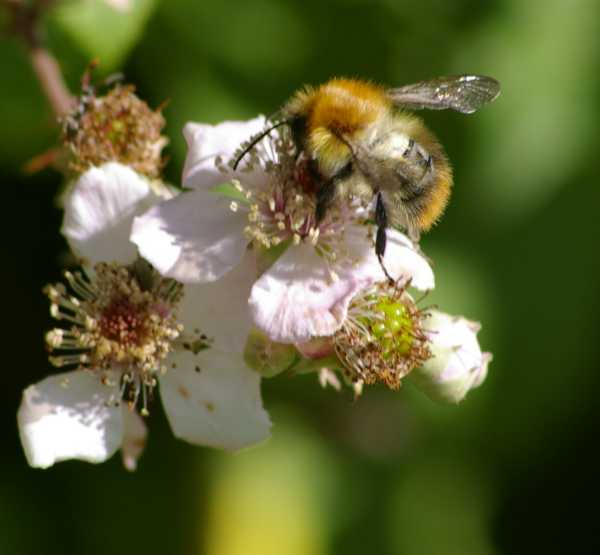The 4 Key Stages Of The Bee Life Cycle For All Bee Species
Updated: Nov 2023
Question:
What are the key stages of the bee life cycle?
The short answer is:
All bees, regardless of species, go through the stages of egg, larva, pupa, then adult.
What Is The Life Cycle Of The Bee?
Bees are not born fully grown. They are born from an egg.
Between the time an egg is laid by a female adult bee (called a 'queen' in some species) and the emergence of the adult, bees undergo a complete metamorphosis - that is, a total transformation in appearance from egg, through to larva, then pupa, and finally adult bee.
Regardless of species however, all bees go through 4 common stages in their development.
4 key stages in the life cycle of bees
A bee life cycle has 4 key stages, whether they be honey bees, bumble bees or solitary species. There are many variations, but the 4 key stages are:
1. EGG
 Egg of honey bee (Apis mellifera) inside a wax cell.
Egg of honey bee (Apis mellifera) inside a wax cell.An egg is laid by a queen or female in a specially prepared cell. The structure and materials used to make the cell may differ depending on species.
For example, honey bee and bumble bee eggs cells are constructed from wax.
 Nest of the common carder bumble bee, Bombus pascuorum, with visible wax cells.
Nest of the common carder bumble bee, Bombus pascuorum, with visible wax cells.However, there is significant variation among solitary species which may select flower petals, leaves, mud, or even resin for nest cell construction.
 Carpenter mimic leafcutter bee, constructing nest cells from leaves, between pieces of paper.
Carpenter mimic leafcutter bee, constructing nest cells from leaves, between pieces of paper.
2. LARVA
In solitary bee species, each individual egg is provided with a food supply then sealed, whereas honey bee and bumble bee larvae are fed by adults as they develop in the cell.
The egg hatches into a larva. The larvae lack eyes and legs, and typically look like a small, curled up grubs, one in each cell.
 Larva of blue orchard bee -Osmia lignaria with food provision (pollen), each inside a cell.
Larva of blue orchard bee -Osmia lignaria with food provision (pollen), each inside a cell.Bees are holometabolous, and as such, they have true grub-like larvae rather than nymphs. The larvae look completely different from the adult which emerges later. In contrast, nymphs resemble immature adults, but usually lack fully formed wings and sexual organs.
The larva feeds on food stores provided by the queen, egg laying female or workers, depending on species.

3. PUPA
 Pupa of the honey bee - Apis mellifera
Pupa of the honey bee - Apis melliferaThe larva is fed until it forms a prepupa. At this point, some features are clearly formed, such as eyes, legs, head, thorax, abdomen.
Some solitary bee species, spin a cocoon and may overwinter (diapause) inside it. The prepupa then becomes a pupa.

4. ADULT
From pupa, new adults emerge. In solitary species, usually the males emerge first, but in bumble bees and honey bees, the first to emerge are female workers followed by males (drone honey bees).
 Bumble bee on Eryngium.
Bumble bee on Eryngium.Adult females mate with males. Females locate a suitable nest site and build cells in which to lay eggs and rear the next generation.
In honey bees the process is different, with a suitable nest site being located by worker scout bees.
- Explore the honey bee life cycle in greater depth, and take a look at images and a video
- Read about the bumble bee life cycle
- Solitary bee life cycles can be explored by species - see the general link solitary bees.
There is wide variation in life spans of adult colony members and queens. Generally, honey bee queens may live some years, where as bumble bee queens may survive for 12 months, some of this time spent over-wintering.
Some solitary species may, over-winter as adults, whilst others may over-winter as full-grown larvae, and mature into adult bees the following spring.
How many broods will bees rear in a year?
There is some variance in the number of broods reared in a year of bees varies according to species. Species may be:
- Univoltine - raising one brood of bees in a year, and therefore with one flight period.
- Bivoltine - raising two broods of bees in a year, and therefore having two flight periods.
- Facultatively bivoltine - some bee species may have one or two broods, usually depending on environmental factors.
- Cleptoparasitic bee species such as nomad bee species lay their eggs in the nests of target host species. The emerging adult females therefore do not construct a nest of their own.
Another type of parasite are the cuckoo bumble bees.
 Female Gooden's nomad bee - a cleptoparasite, by the entrance of a target host nest burrow, usually an Andrena (mining bee) species
Female Gooden's nomad bee - a cleptoparasite, by the entrance of a target host nest burrow, usually an Andrena (mining bee) species


